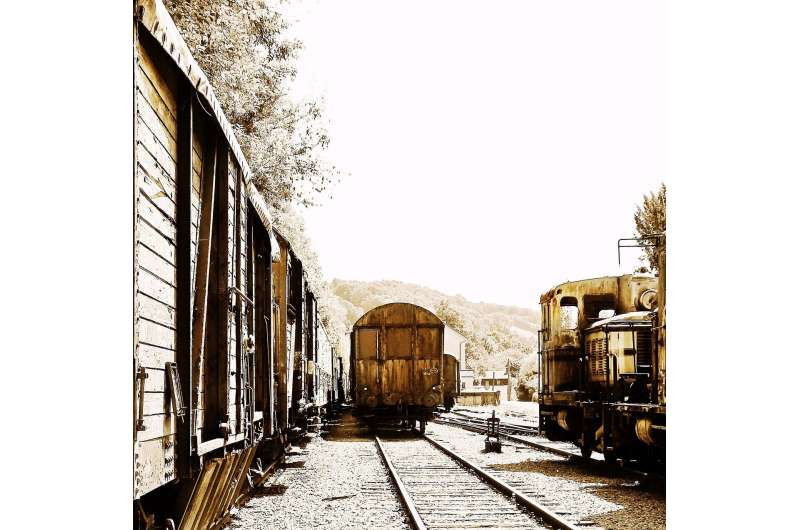How rail accidents with hazardous materials affect people's property values

A decade ago, U.S. crude oil was not transported by rail in the United States—not one drop. After an unprecedented expansion of domestic energy production, the use of trains became more common.
When these hazardous petrochemical materials pass through urban areas with dense populations, the public has good reason to be concerned. But, whether it's by train, boat or pipeline, transportation only becomes a mainstream topic when there's an accident, which can cause human health risks, property damage, evacuation and environmental degradation.
These accidents leave behind obvious physical damages. But what about the impact on people's property values?
The University of Delaware's Martin Heintzelman and his collaborators published a new research study in the Journal of Urban Economics on rail derailments involving hazardous materials and the impact on property values. They found the negative impact on housing property values lingers for almost a year and a half. The project was motivated by the dramatic increase in shipment of oil by rail in the last decade and prominent accidents like the July 2013 Lac-Megantic disaster in Quebec. In one of the worst rail disasters in Canadian history, 47 people were killed and more than 40 buildings razed. A common theme at the center of the tragedy was a small town grappling with the aftermath. Similar high-profile accidents in the U.S. increased attention on freight rail safety and the aging fleet of tanker cars.
The central debate of hazardous material transportation is the comparison between rail and pipeline.
"There has been substantial debate about the expansion of petroleum pipeline networks. This combination of issues got me thinking about the tradeoffs associated with these infrastructure decisions," said Heintzelman, the Department of Applied Economics and Statistics chair and professor. "One piece of that is to understand how homeowners value risks they may face from rail accidents where more hazardous chemicals are being shipped via rail."
The researchers specifically wanted to know the effect of derailments on property values. They looked at 33 derailments in the state of New York between 2004 and 2013. On average, a derailment depreciated housing values within a one-mile radius by 5% to 8%. It took 480 days for housing prices of affected properties to return to pre-accident levels. Findings also showed that the impacts of derailments on property values were limited to the local area. People who lived farther away were spared, with no significant impact. At other locations unrelated to the accident, media coverage had no effect on property values with houses nestled near rail lines.
"This suggests that people living in the market only respond to local accidents and not to general concerns about being near rail lines," said Heintzelman. "It was somewhat surprising to find that major accidents did not have a significant broader impact, since we expected these accidents to impact people's risk perceptions of rail lines."
In 2010, U.S. crude oil was not transported by rail. By 2014, rail shipments peaked at 25.8% of all oil transport. The most recent annual figures (2019) broke down to 87.9% shipped by pipeline, 7.4% by rail and 4.7% by water.
"The shift to rail was driven by the huge expansion in domestic oil production since 2007 and an existing pipeline network not equipped to deal with that change," said Heintzelman. "Since 2014, pipeline capacity has expanded and caught up to demand."
Compared to rail, sending oil via pipeline is a much safer endeavor. But expanding this network requires new infrastructure in sometimes remote and ecologically sensitive areas. Heintzelman points out that expanding rail transport takes advantage of existing infrastructure in areas already subject to many of the negative externalities associated with rail freight.
"Additional rail transport, in general, does not require additional approvals, while pipelines do require that," said Heintzelman. "This made pipelines a focus for climate change activism as they are seen as additional investment in an industry not compatible with climate goals, and potentially stopped by the permitting process."
Of the many studies that have investigated how disasters affect property values, most suggest that people react in the immediate aftermath, but property prices typically recover soon after as the public's reaction to the accident fades with time.
"It is surprising that big events do not seem to drive the sort of general re-evaluation of risk that you might expect," said Heintzelman. "The only people who seem to respond are those directly affected and very near an accident."
With the study published, Heintzelman plans to extend his related research on the value of environmental amenities and the impacts, values, and drivers of renewable and other energy infrastructure.
More information: Chuan Tang et al. Rail accidents and property values in the era of unconventional energy production, Journal of Urban Economics (2020). DOI: 10.1016/j.jue.2020.103295
Provided by University of Delaware




















